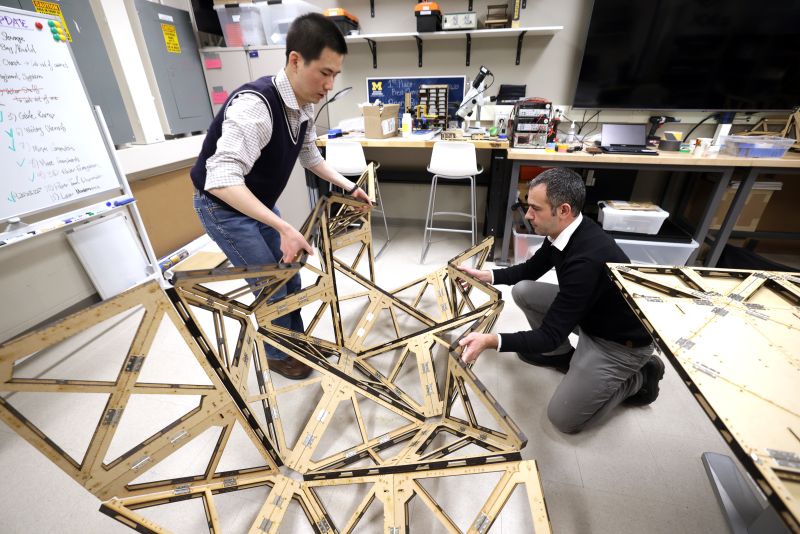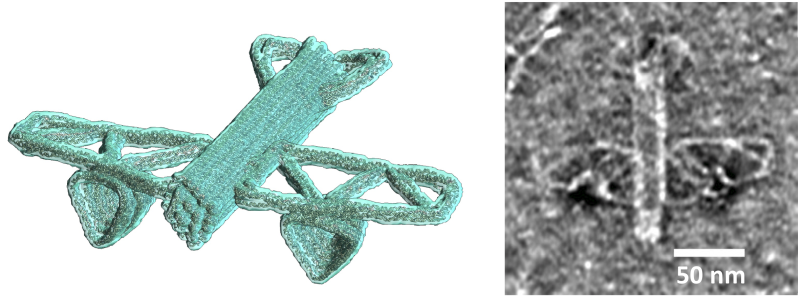
Addressing real-world challenges using origami
Celebrate World Origami Day by learning about 5 NSF-supported projects advancing science and technology
When most people think of origami, they envision a sheet of paper folded into a 3D object, such as a crane or an airplane. However, origami is rooted in mathematical principles that make this ancient art form a valuable tool.
In nature, origami patterns enable insects to fold and unfold their wings and allow plants to open and close their leaves and flowers into precise shapes. Likewise, the ability to transform 2D sheets into structurally sound, compact, 3D shapes using origami techniques has influenced the design of takeout containers and airbags.
Today, research using the science behind origami has produced breakthroughs in fields as diverse as architecture, medicine, biology and robotics.
Here are five NSF-driven projects that use origami-inspired research to revolutionize STEM fields, develop new technologies, and address real-world problems in science and engineering.
Engineered structures
Origami engineering is unique in that it allows objects to fold compactly and transform into different shapes while maintaining structural integrity. A team of researchers led by Evgueni Filipov, a professor at the University of Michigan, demonstrated that origami engineering can be used in the design of load-bearing structures. This advancement will allow for infrastructure that can be transported efficiently and reconfigured for different environments and functions.
These origami-inspired structures can be rapidly deployed, which will speed up construction and enable more rapid rebuilding of structures following natural disasters. This technology will be useful for structures that need to be built and disassembled quickly, such as event stages. Moreover, each structure can transform into a range of configurations, including shelters, bridges, walls, floors and columns. This adaptability will extend the life cycle of structures that are no longer needed by allowing them to be reused instead of demolished, which will have environmental and economic benefits.
Laparoscopic cleaning devices
Laparoscopic surgeons — who examine organs using a laparoscope inserted into small incisions — require proper visibility at surgical sites, which necessitates removing, cleaning and reinserting the scope periodically during a surgical procedure. This increases operating times and imposes additional risks for patients. To address these challenges, Bloom Surgical CEO Jacob Sheffield and co-founder Ian Esplin developed a novel micro-mechanical wiping device.
The team used origami-based engineering to create a small, flexible “windshield wiper,” controlled by the surgeon, that attaches to laparoscopes and endoscopes. The geometry and flexibility of this device allow it to quickly expand and contract so that a surgeon can rapidly clean the scope without having to remove it from the surgical site. This technology will reduce disruptions during surgeries, reducing procedure times and improving patient outcomes.
DNA gene therapy
DNA origami is a technique of folding DNA into 2D and 3D shapes at the nanoscale. These compact but dynamic structures have design capabilities that could enable new diagnostic tools, more targeted therapeutics and improved genome engineering. A team of researchers led by Carlos Castro, a professor at The Ohio State University, demonstrated DNA origami as an efficient strategy to deliver DNA nanodevices into cells for a variety of functions.
Researchers used origami designs to fold genes tightly into packages that were delivered into cell nuclei and integrated into the genome at target sites using CRISPR-Cas9 gene-editing technology. The compact origami folding allowed delivery of even very long genes with high efficiency and low toxicity. This is a key advancement from other technologies, which are limited to relatively small segments of DNA.
The results of this study show promise for using DNA origami to create therapies for diseases caused by multiple mutations in genes, which remains a challenge for genetic medicine. More broadly, development of DNA origami tools to measure and manipulate cell functions has the potential to advance medical, agricultural, environmental and engineering fields in many new directions.
Robots that adapt to changing environments
Natural environments are complex, dynamic and often inaccessible and resource-limited for human operations. This poses numerous challenges for long-term environmental monitoring and protection. A team of researchers led by Suyi Li, a professor at Virginia Tech, is using principles of origami to create robots with unique designs that allow them to operate in dynamic environments for extended periods without human intervention.
To enable long-term operation of robots in natural settings, the team is incorporating mechanisms that allow plants to adapt and survive in dynamic environments. The researchers are using origami principles to create accordion-like robotic “trunks” that can fold and self-lock. These origami trunks are load-bearing and can accommodate sensors for environmental monitoring. The origami folds allow the trunks to expand and contract in response to changing environmental conditions that reduce available space, such as plant growth.
The adaptability of these origami robots will allow them to monitor and respond to long-term processes such as pollution spread and real-time events like wildfires. This technology will revolutionize researchers' ability to study remote regions, protect the environment and respond to disasters.
Improving STEM education
Visuospatial skills are a key component of many science, technology, engineering and math fields. However, such skills are often underdeveloped in underserved learners in the U.S., resulting in achievement gaps and underrepresentation in STEM. Although there are increasing efforts to develop evidence-based visuospatial interventions, most are implemented in a lab setting in ways that are difficult to translate into classrooms. Origami can serve as an engaging educational tool that encourages students to develop and apply spatial skills and use logical and sequential thinking. A team of cognitive psychologists, learning scientists, mathematics education researchers and origamists implemented and evaluated an origami-based curriculum in classrooms to help elementary school English language learners develop visuospatial skills.
The curriculum used origami in hands-on lessons to demonstrate visuospatial concepts such as position and orientation, symmetry, reflection and spatial relations. The team evaluated the effectiveness of the learning program for developing visuospatial skills and improving mathematical competencies.
Origami proved to be a valuable tool for helping students develop visuospatial skills. Students who participated in the program showed significant improvements in math-specific spatial vocabulary and reduced math anxiety. Incorporating the origami-based curriculum more broadly into STEM education for underserved learners will help close learning gaps, better prepare students to enter STEM fields and improve representation.







